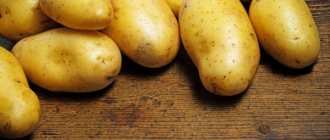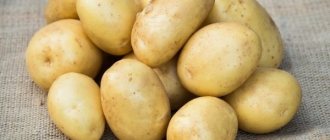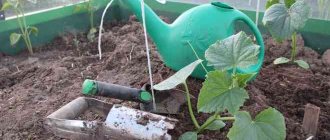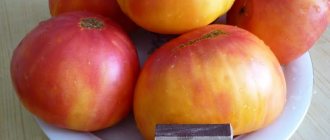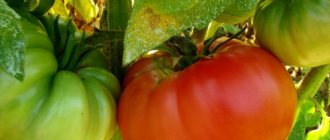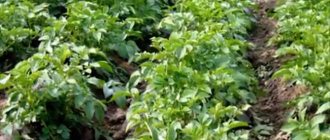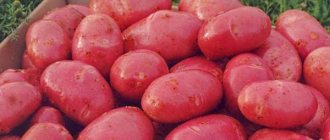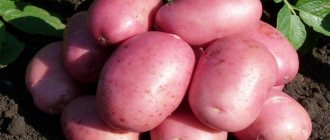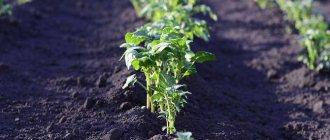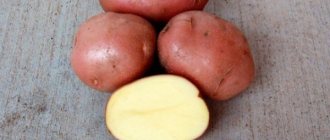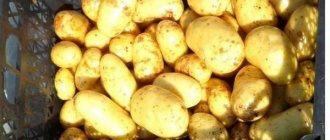Vegetable growing » Potatoes
0
1705
Article rating
Kira Stoletova
Different varieties of potatoes have their own advantages and disadvantages. Many of them have similar general characteristics. One of these varieties is the Belarusian potato Lileya.
Characteristics of Lileya potato variety
Lileya potatoes have good commercial and taste qualities. It is unpretentious to growing conditions and adapts well to weather changes. The productivity of the variety is always high, but it responds to the application of mineral fertilizers by increasing productivity.
Description of the plant variety
Like any other variety, Liley has certain distinctive features. Let's consider the composition, origin and characteristics of the culture.
Origin and development
This is an early table potato variety. Originally called Liley Belorusskaya, it then spread to four regions of Russia, and in 2008 the official name was shortened to simply Liley. Distributed in the Northern, Northwestern, and Central districts of the Russian Federation.
Chemical composition
The composition of this variety is not much different from others. Its peculiarity is its high sterol content.
The composition also contains:
- amino acids;
- carotene;
- organic acids;
- starch (about 15% in one root vegetable).
Lily is rich in vitamins A and B, so it is perfect for anyone who follows a healthy diet.
Characteristics and appearance
The appearance of the plant is typical - a bush of medium height, moderately spreading. The stem itself is straight with a lot of green mass. The leaves are medium-sized, green with a slight wavy edge. The corolla flowers are quite large and light.
Nests are formed by 8 to 15 tubers, which have an oval or round shape, each weighing about 200 g. Lily tubers are approximately the same, small ones are rare. The potato skin is yellow, dense and smooth. The pulp is light yellow and does not darken when cut or cooked. The eyes are small, few and shallow.
The marketable yield is high - from 250 to 400 c/ha.
What regions is it suitable for?
The variety is cultivated in all regions of the Russian Federation. The crop shows excellent productivity not only in the south, but also, for example, in the Vologda region: with proper agricultural technology, indicators reach 650 c/ha.
The variety is also suitable for northern regions. It takes root well in the Arkhangelsk and Murmansk regions, although it does not give such indicators as in the southern regions.
What is the difference from other varieties
Lily differs from other varieties in many ways:
- increased resistance to unfavorable climate;
- larger tubers;
- neat in appearance, without defects;
- undemanding to different types of soil;
- gives a good harvest not only in the first years of cultivation, but also in subsequent years;
- bred specifically for cooking.
These advantages distinguish Liley from other varieties.
Lilly and Lileya
There is a potato variety similar in name to Liley. Lilly is a mid-early variety that belongs to the table variety. Its yield is also high, but it was bred relatively recently, so it has not yet become as widespread as Liley.
Moreover, it differs in external features. Lilly tubers have an oval shape, medium or small size, and many eyes. Taste qualities are characterized as average. It is more common in the northern parts of Russia, resistant to various diseases and frost-resistant.
Is it worth planting: all the pros and cons of the culture
Like all vegetable crops bred through selection, Lily has its advantages and disadvantages.
Advantages of the variety:
- Root vegetables with high taste qualities and long shelf life.
- With proper care, the variety shows high productivity.
- The dense skin of the tubers protects them from mechanical damage, which is important during harvesting and long-distance transportation.
- Resistant to sudden temperature changes.
- Natural immunity to various diseases and pests.
- Early ripening variety. The ripening time of the culture is 60-70 days.
In just 10 years of existence of the variety, the vegetable has gained great popularity both among amateur gardeners and farmers who grow this crop on an industrial scale. Among the disadvantages of the variety, its demands on fertile and fertilized soils are noted. Potatoes will grow in any soil, but the yield will not please you.
The main advantages and disadvantages of the variety
The Liley variety is a universally recognized “favorite”. It is no coincidence that it has become so widespread and is in demand among summer residents.
Experts consider the following features to be advantages:
- high productivity;
- resistance to various weather conditions;
- versatility of tubers;
- good external data;
- high taste and product indicators.
It has practically no disadvantages, with the exception of vulnerability to pests and diseases. However, these disadvantages are also inherent in other potato varieties. But with proper care, the risks of infection and pest attacks are reduced to a minimum.
Growing
The characteristics of the Lileya variety indicate that it is a fairly high-yielding crop. However, the quality and quantity of fruits are influenced by the nuances involved in growing the plant. Thus, according to the recommendations of fruit and vegetable growers, potatoes should not be planted in the place where nightshade crops grew before. The best predecessors for the variety will be:
- cucumbers;
- annual herbs;
- legumes;
- cabbage crops.
In this case, the soil should be fertile, loose and light. You can improve the quality of the soil in the fall by plowing the soil to a depth of 30 cm and adding humus with complex fertilizers.
See also
Description of the Kiwi potato variety, its characteristics and yieldRead
Pre-sprouted potatoes are planted. The best time for this will be the end of April or the beginning of May, when the soil warms up to 10 degrees. Planting pattern: 35 cm between bushes and 80 cm between rows.
Features of planting and growing varieties
Even a novice gardener can grow this unpretentious variety. However, it is important to know the basic rules of agricultural technology and focus on weather conditions. Let us examine in detail the features of potato cultivation.
Preparing for landing
To begin with, choose the right seed material. You will need small, evenly shaped specimens without damage or dark spots. It is not necessary to treat tubers with chemical disinfectants, but growth stimulants (for example, Epin, Bioglobin and other safe products) will not hurt.
About a month before planting, potatoes are germinated in a well-lit place. At this point, the tubers are slightly moistened by spraying plain water on both sides. When the sprouts reach 1.5 cm in length, the potatoes can be planted in open ground.
Dates, scheme and rules of planting
There is a certain planting scheme, compliance with which guarantees the formation of larger and more numerous tubers.
Potatoes are planted in the ground when the soil is warm enough. It is important to take measurements: at a depth of 8 cm, the soil should be heated to +10°C.
Planting pattern - 60 by 30 cm: do not allow the bushes to grow too close, shading each other. Some gardeners use a 80 cm per row pattern in order to increase the yield.
When planting, the holes should be about 10 cm deep; it is advisable to plant large tubers deeper, and small ones closer to the surface. In dense soil, a depth of 5-6 cm is sufficient.
Features of cultivation
With fertilizing, the yield of the variety will be 20-40% higher. The best option is a mineral complex that contains the entire set of necessary elements. Sometimes nitrogen fertilizers are used to accelerate the growth of tops. However, excess fertilizer will not be beneficial - 2-3 fertilizing is enough for potatoes during the season.
Important. Monitor weather conditions. If the season is rainy, there is no need to water the tops, otherwise the tubers will rot.
Nuances of care
In addition to watering, you need to weed and hill up the beds in a timely manner. They are treated three times a season, carefully removing weeds. It is advisable to mulch with cut grass or even straw. During this period, fertilizing is also recommended, for example, mineral fertilizers based on potassium and magnesium, mixed with bird droppings.
Farmers know that there will be fewer weeds if they periodically loosen the soil using a simple rake or harrow. Loosen diagonally so as not to damage the tubers. This method allows not only to remove excess grass, but also to improve the “respiratory system” of the soil, retaining the required amount of moisture in it.
Watering mode
Excess moisture can lead to stunted growth. Watering depends on weather conditions. During drought, water 1-2 times a week. When flowers form, the amount of water is increased.
Watering time is either early morning before the bright sun appears or late evening.
Top dressing
The plant is fed twice after planting. The bushes are sprayed with superphosphates, and growth stimulants are also used three times during the growth period. The first time is fertilized during the formation of leaves, the second time during the appearance of buds, the third time when tubers are forming.
Disease and pest control
Colorado potato beetles are equally harmful to any variety. Insects are collected by hand; for prevention, the plantings are sprayed with onion peel tincture.
In addition to the Colorado potato beetle, wireworms attack potatoes. To destroy the pest, insecticides are used and the beds are regularly loosened and hilled.
Among the diseases, late blight is known; this disease affects potatoes during rainy periods. To avoid disease, the bushes are sprayed with Fitosporin. If the bushes are already sick, they are sprayed with a solution of copper sulfate (10 liters of water and 2 g of sulfate) for 10 days.
Potato diseases and pests
The main enemy of this vegetable is the Colorado potato beetle . The only effective way to combat it is with insecticides. Spraying is carried out at the stage of appearance of larvae on the leaves. You need to choose a dry, windless day. If it rains after spraying, it will have to be repeated.
Lily tubers are sometimes affected by wireworms. Prevention of its occurrence can be wood ash in the holes or treating the tubers before planting.
Harvest and storage
To prevent potatoes from spoiling, they must be collected and stored correctly, following simple rules.
How and when to collect
You can try the tubers for the first time in July. But this is only a small part; the main collection period is August. Choose a dry day. Make a fence on the site that will create shade and at the same time be ventilated from all sides. This is where you need to put the dug up potatoes. Three weeks after harvest, sort the potatoes.
Storage Features
Store potatoes in a dry, cool place with a temperature of +2 to +5°C. The best container is a mesh or box. The keeping quality of the variety is 90% and above.
Correct fit
Basic rules for planting the Lileya variety:
- Maintain crop rotation. Correctly changing plants on a site helps preserve the beneficial properties of the soil, and is also effective in combating diseases that are unable to take root in one site, since crops are constantly changing;
- Plant after green manure grasses, root vegetables, cucumbers, cabbage, and legumes. Do not plant after tomatoes, eggplants and peppers;
- In autumn, humus is distributed on the site. Afterwards, the soil is deeply plowed, while simultaneously mixing with organic fertilizer. You can replace organic fertilizers with mineral fertilizers with phosphorus and potassium;
- Three weeks before planting, seed material is prepared. Seed material is germinated in a warm and well-lit room. To speed up the process of sprout formation, seed material is placed in plastic bags with holes for ventilation. Thanks to the greenhouse effect, the tubers will germinate in 5-7 days;
- Pre-planting treatment of planting tubers is carried out with fungicides and insecticides to prevent the occurrence of diseases and damage by insect pests;
- Plant seed material in soil heated to +10 ºС;
- The distance between holes is maintained at 35 cm, row spacing is at least 50 cm;
- Manure or bird droppings are added to the planting holes. Add a glass of wood ash to the acidic soil. You can replace organic fertilizer with mineral fertilizers containing phosphorus and potassium (one teaspoon of dry fertilizer per hole);
- After the hole, you need to dig in and carefully level the soil using a rake.
Advice from experienced gardeners and reviews about the Lileya variety
Let's give some advice from farmers with experience in growing the Belarusian variety:
- Lily loves to be watered. If nature is favorable, then the potatoes will grow on their own, no additional feeding is needed.
- Apply foliar feeding twice a month. Spray the bushes with a superphosphate solution.
- It is better to use nets rather than bags or boxes for storage.
You can find many different reviews about the Liley variety.
Tamara, Krasnodar: “I decided to try a new Liley variety for myself. I planted it without any problems, in our south it grows well. The taste was excellent, the potatoes themselves were dense and large. Goes well in soups, purees and for French fries.”
Igor, Novosibirsk region: “I’ve heard a lot of praise about Belarusian potatoes. It turned out that it was not in vain. Lileya potatoes are smooth, without foulbrood. It grows well, is almost not susceptible to diseases and pests, but requires constant care. Overall I’m happy, now I only plant this variety.”
Reviews
Big Momma, Clean Keys
My boys love French fries, but I’m afraid to buy them often - I don’t know what they were fried in or where they were cooked. Therefore, I have already tried a lot of varieties for home frying. Quite by accident I saw a Belarusian television program where they talked about the new potato variety Lileya and showed dishes made from it. I bought a small mesh for testing, and since then I have no worries about what to feed my sons - very tasty potatoes and fries, and mashed potatoes, and just boiled ones. Unfortunately, it is not yet possible to buy potatoes of this variety everywhere; I will order them from a Belarusian online store.
Yulia Nikolaevna, Tula
Lileya is a real brand of Belarusian bulba: tasty, beautiful, productive and very tasty. And most importantly, ours, bred in our climate! We have only grown it for 1 year, but I can already say for sure that we will continue to buy this seed material. This year we planted half a bucket of this variety of 1 reproduction at the dacha, and collected 11 buckets! The seeds are not as expensive as Dutch ones, and the taste and abundance of these potatoes are beyond praise. Well done Belarusians, keep it up!
Belova_Ir_Nik, Pskov
Lily is a good potato, we have been planting it for 3 years, we decided to update our Dutch seeds. We chose it so that it would not get sick in our climate, so that it would not be doused with pest control chemicals, so that it would be well stored, productive and tasty. We thought we wouldn't find it. We bought 3 varieties for renewal, all of Russian and Belarusian selection. But the Liley variety turned out to be the best. We collected 15-18 smooth, clean tubers from each bush; they lay in the cellar until February without problems, without germination. And I liked the taste - whether in a frying pan or in soup. 100% recommend!
Potato Liley: yield, origin, reasons for popularity
As soon as the bushes of the plant begin to dry out and wither, the root crops are ready for harvesting. The tops are cut 5-7 days before the start of harvest. Dig up potatoes with a pitchfork, this way there is less chance of damaging them. After the root crops are dug up and cleared of excess soil, they are dried in the sun and planting material is selected for the next planting work.
During the storage period, root crops are sorted and sorted. Strong and healthy potatoes are sent for further storage, rotten and spoiled ones are thrown away, and the rest are eaten. With the right approach and conditions, potatoes can easily be preserved until spring.
The moment of ripening is easy to see - the bushes begin to wither. After this, you can start collecting potatoes. Before starting the process, it is better to cut off the vegetation and this should be done a week in advance.
You need to dig up the tubers with a pitchfork, as a shovel can damage them. The tubers are cleaned, dried and sorted. Some of the material is put aside for next year.
Potatoes are stored well in wooden boxes in the cellar
Once every two to three months, the collected tubers are checked and the rotten ones are thrown away. If properly organized, they are stored until May.
You can estimate the harvest period yourself. To do this, you need to carefully monitor the tops of the plant. If green foliage is observed on the potatoes, it means that the process of growth and development of the tubers has not yet ended. Therefore, it is too early to harvest. As soon as the tops acquire a yellowish tint and begin to dry out, you can safely begin digging potatoes. To facilitate this process, it is recommended to completely cut off the stems and leaves approximately 2-3 days before harvesting.
After the potatoes are dug, their tubers must be dried. To do this, they are laid out on plastic wrap and left in the sun for about 3–4 hours. After this, the potatoes are cleared of soil and sorted into food, small items and planting material. Then the harvest is put into bags and taken for storage.
The Lileya potato variety is stored exclusively in the cellar, at a temperature of 2–3 degrees above zero. In this case, the underground room must have a ventilation hood. For ease of storage, wooden boxes and mesh bags are used. Such recommendations are due to the fact that the bulb should be removed from rot once every 3 months.
Having considered the above characteristics, advantages and features of the Lileya variety, you can independently verify its uniqueness. Having planted this crop, either in agricultural enterprises or in small gardens, every fruit and vegetable grower will be satisfied with the quality of its products.
Harvesting Lilly potatoes is similar to other potato varieties.
Potatoes are dug 50-60 days after they are planted in the soil. The growing season may vary slightly depending on the weather conditions of the region.
The readiness of the fruit for harvesting is determined by the change in color of the tops - it should turn yellow. To facilitate the process of digging potatoes, the tops should be cut off 2-3 days before harvesting.
It is recommended to dry the dug up potatoes. To do this, the tubers intended for food are poured onto the floor in a well-ventilated area. The potato layer should be no more than 20 centimeters. It is important that the floor is not concrete, preferably wooden. Dry the potatoes for at least 10 days, turning the tubers periodically. Seed potatoes can be dried in the sun.
Lilly has a high shelf life. In favorable conditions, potatoes can be stored for 9 months without losing their quality.
Potato Liley: yield, origin, reasons for popularity
Despite its recent appearance, the variety has already earned popularity among agronomists, gardeners and consumers. The reason for this is the presence of those qualities that are required by each category of fans of this variety. Agronomists, farmers and industrialists value it, first of all, for its productivity, unpretentiousness, ability to store and transport, resistance to diseases and adverse conditions. Gardeners and potato consumers value it for its excellent taste and versatility in the use of tubers.
Description and characteristics
Lily is a mid-early table variety. It is valued for its high yield and excellent commercial qualities. From the appearance of the first shoots to the harvesting of the tubers, 70-75 days pass. Potatoes form moderately spreading and medium-sized bushes of intermediate type. The plant is covered with small dark green leaves with slightly wavy edges. Compact inflorescences with large, snow-white flowers grow on semi-vertical stems.
One bush produces from 13 to 15 root crops of a round, slightly elongated shape, with a smooth yellow skin. According to the description, the flesh of the Lileya potato variety is dense, creamy-white in color. Shallow, medium-sized eyes are found on the surface of the tuber. The weight of the root crop varies from 110 to 200 g. On average, gardeners harvest 320 centners of potatoes per hectare, so this variety is ideal for industrial cultivation. The maximum yield was 680 c/ha.
Belarusian Liley has excellent taste. One tuber contains 11-17% starch, so potatoes do not get soft when frying, boiling, baking and stewing. It is suitable for making purees, salads, soups and baby food.
Features of care
To create comfortable conditions for the variety, it will be enough to follow simple agrotechnical work.
Plant care includes:
- Watering. Irrigation is carried out as the soil becomes dry. The best option for irrigation is the drip method. Using this method, all bushes will evenly receive the required amount of water.
- Weeding. Timely removal of weeds and loosening of the soil will contribute to the quality development of the root system.
- Hilling. Rolling the soil to the lower parts of the plant increases the space for the development and growth of tubers. This manipulation is carried out at least 2 times during the entire period of growing potatoes.
- Feeding. For intensive plant growth, complex fertilizers are used. They are introduced in liquid form, having previously been combined with droppings.
By following these rules of care, it will be possible to increase the merits of the variety.
